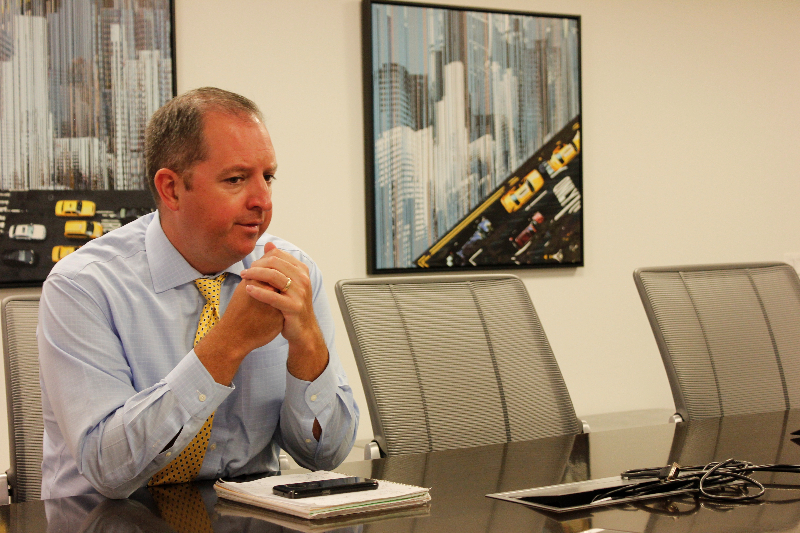Education
Valuing Catholic Education–and Trying to Keep the Doors Open
By Olivia Medina
Spectrum staff
Brian Fox so believes in the value of a Catholic school education that he already is scouting the right ones for his 2-year-old son and 4-year-old daughter.
“In public school, you’re just another number and a part of their system,” said Fox, 42, a New York City Police Department officer and graduate of La Salle Academy, an East Village Catholic school, offering his opinion.
When he was an eighth-grader at Roy H. Mann, an intermediate school in Mill Basin, Brooklyn, Fox decided he’d be better off switching to a Catholic school. From what he could tell, Catholic school teachers seemed “more invested and cared about the students succeeding … There was no child left behind.”
He expresses that kind of confidence in Catholic schools at a time when their numbers have declined nationwide. Between the 2003-04 and 2013-14 school years, the number of Catholic school students across the country dropped from 1.2 million to 740,000, according to the most recent data from the National Center for Education Statistics. Catholic schools enrolled 38 percent of all the nation’s elementary and secondary students in private schools in 2013-14.
Locally, since 2011, 58 Catholic schools under the Archdiocese of New York closed, bringing the remaining number to 217, according to the New York Post. The Archdiocese of New York covers Manhattan, the Bronx and Staten Island in New York City, and parts of Long Island.
In an effort to keep the doors open at those remaining schools, Catholic leaders have made several moves. For example, in 2012, Monsignor McClancy Memorial High, which was one of the last all-boys schools in Queens, started enrolling girls, too. During the last decade prior to 2012, McClancy had lost 100 students, bringing its enrollment to 450. After the school turned co-ed, the student count rose to 660 by 2015, according to the latest available data from the Diocese of Brooklyn, which oversees Catholic schools in that borough and Queens.
The 2017 graduates of that East Elmhurst, Queens school received $23 million in academic scholarships, according to the school’s website.
Martin Cottingham, 47, a real estate agent who is on the board of directors for Futures in Education for Brooklyn and Queens, a Diocese of Brooklyn body that grants student scholarships, and on the board at La Salle Academy. To be sure, he said, Catholic leaders have been forced to take a different approach.
The aim of consolidating single-sex schools and making them “co-ed … is to just be more competitive, and bump up enrollment, and all the reasons you can think of,” Cottingham said. “The reality is that it’s … all about enrollment and competing.”
He continued: “The model is being challenged right now, on many fronts … [Catholic schools] don’t have the funding that public schools and charter schools get. They have to compete with those schools.”
Among other concerns, some Catholic schools struggle to adequately pay teachers and other staffers.
In a separate move, the Diocese of Brooklyn, in the 2016-17 school year, merged several elementary schools into academies. That, also, was an effort to spread around resources.
“You had schools and churches every ten to fifteen blocks,” Cottingham said. “There was no need for that, especially for schools in smaller neighborhoods.”
Futures in Education also raised money to award more than 6,000 scholarships to children attending elementary schools in Brooklyn and Queens. And the organization runs the Angel Program, whose donors give a minimum of $1,500 a year to lessen tuition costs for lower-income Catholic elementary school students.
Covering Catholic education costs is a challenge for some parents who want their kids in those schools, Fox said. His two nephews attend St. Edmund’s High School in Brooklyn, where the annual price tag is roughly $12,000 per student.
“The Catholic Church needs to, at some point, not treat it so much like a business … but to get to the grassroots where they care about the child,” Fox said, “and not how much tuition is.”
Cottingham noted that when he was at La Salle, the student body mainly came from middle-class families. But “the boys that are there today are [of] minimal means. A good amount of them come from single-parent homes, and there’s minority kids … And some of the larger public schools and schools in their neighborhood just aren’t up to par. A Catholic school like La Salle fills that void.”
“My experience at a Catholic school was phenomenal,” Fox said. “I really attribute my success in life to going to Catholic school.”


